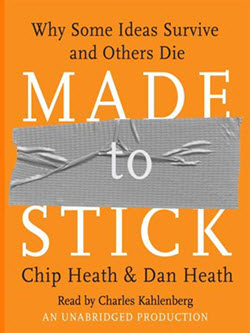Content Marketing Stickiness
 Content Marketing Stickiness
Content Marketing Stickiness
A Stickiness Framework from “Made to Stick”
I really like the book Made to Stick by Chip and Dan Heath. I own both the book and the audio CD.
They go into detail about a framework that can be used to evaluate whether an idea is “sticky” or not.
Here are the six core parts of their framework:
- Simple
- Unexpected
- Concrete
- Credible
- Emotional
- Stories
This book is required reading if you create content to market your business. Here is a summary of the framework so that you can get an idea of how it can help verify your content ideas.
Simple
Is the idea simple to understand and explain? A good way of testing this is to force yourself to explain the idea to someone who you previously haven’t spoken to about it. If you can do this quickly and they understand it, then it should be simple enough.
The other thing to remember here is if you can’t explain the idea quickly and easily, then you are probably also going to struggle when it comes to promoting the idea in your blog, website, email or other ways to deliver a message to your audience.
Simplicity is important.
Unexpected
This doesn’t mean that your message needs to be totally unexpected, but it helps its stickiness if there is something unexpected about it. It may be the title, a photo a graph or the story itself.
If all your doing is what been done before and you are not adding your unique twist to it or not adding anything unexpected then you may struggle to get coverage and generate interest.
Concrete
Here is a great example from our Put-A-Man-On-The-Moon program. When JFK made this speech in 1961 about landing a man on the moon, his wording was very concrete. It had to be because he wanted to capture the imagination and support of congress and the US public. This is what he didn’t say:
“We will do a good job with the space race.”
If he had said this, he wouldn’t have been wrong. He did want to do a good job. However, it’s not concrete. What does it actually mean?
Contrast this with what he actually said:
“. . . this nation should commit itself to achieving the goal, before this decade is out, of landing a man on the moon and returning him safely to the Earth”
We all knew what nation he was referring to. It was time-bound. A man would be put on The Moon. The man had to be returned safely to Earth. This was clear and concrete.
Credible
There are two types of credible when it comes to content we may produce.
The first one is the credibility of the author.
The creator of the content needs to be an expert on the topic.
Then the brand behind the content also needs to be qualified to create content on the topic.
Keep in mind that an expert on one topic does not qualify him or her to be an expert on all topics.
Emotional
How can you trigger an emotional response through your content?
You can move people with emotion. This is important to understand. Emotion gets us to move and then we justify our actions with facts (often after the fact).
Also, do not try to create an emotional response just to gain backlinks. As valuable as in-coming links are I do not recommend trying to create an emotional response just to gain backlinks.
Stories
The final element of the Heath’s framework is whether your content tells a story. A story can inspire people to take action and a story can help people to remember. People love a good story and we tend to remember a great story.
I recommend making a simple checklist for your content pieces and see how many of them you can tick off when you feel you are ready to publish the piece. To use a checklist will help you to create better, more interesting and stickier content.
Here is an excerpt from the Amazon write up on the book . . .
MADE TO STICK is a book that will transform the way you communicate ideas. It’s a fast-paced tour of success stories (and failures)–the Nobel Prize-winning scientist who drank a glass of bacteria to prove a point about stomach ulcers; the charities who make use of “the Mother Teresa Effect”; the elementary-school teacher whose simulation actually prevented racial prejudice. Provocative, eye-opening, and often surprisingly funny, MADE TO STICK shows us the vital principles of winning ideas–and tells us how we can apply these rules to making our own messages stick.
